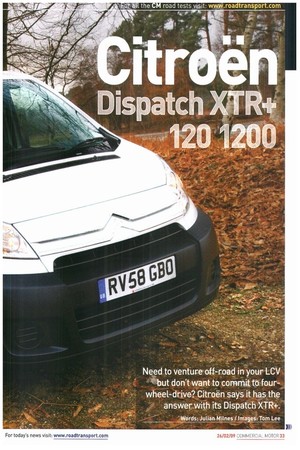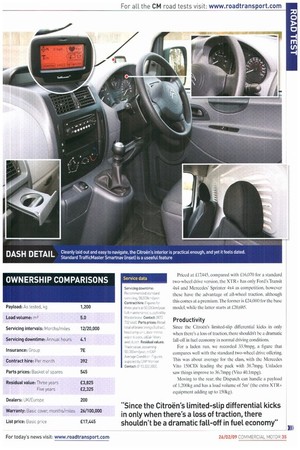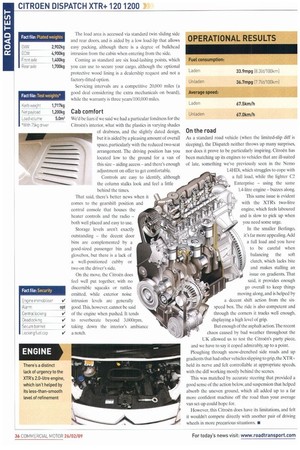Need to venture off-road in your LCV but don't want
Page 33

Page 34

Page 35

Page 36

If you've noticed an error in this article please click here to report it so we can fix it.
to commit to fourwheel-drive? Citroen says it has the answer with its Dispatch XTR+.
Words: Julian Milnes / Images: Tom Lee
In the great scheme of things, the average van driver doesn't really have to venture off-road, and, therefore, is happy with their traction arrangement — either from the two front or the two rear wheels, working in harmony on some nice grippy asphalt.
On rare occasions, though. an LCV will have to reach a location that is beyond this comfort zone, venturing on to muddy/slippy/rough ground to deliver a parcel, deliver materials to a building site, or fix a fault at a sub-station.
If this is the case, the driver will want to be reassured that what's available below is good enough to see them there and back.This would normally mean looking for a van with four-wheel-drive, but Citroen believes it has devised a setup that's cheaper and lighter than a full-blooded 4x4.
Badged XTR-F, and based on the company's Dispatch van in L1H1 guise, it uses an FAM reinforced traction limited-slip differential that automatically channels 75% of the engine's torque between the two front wheels, when it senses slippage. Citroen claims this will enhance grip in tricky situations, keeping you going when a traditional two-wheel arrangement might end up floundering.
Backing this up is heavy-duty suspension that raises ground clearance by 30mm, revised steering geometry, underbody and engine protection, as well as Michelin snow and ice tyres.
Elsewhere, it's a standard Dispatch 120 1200, so that means a two-litre, 16-valve common-rail unit, which produces 118hp and 300Nm of torque, mated to a six-speed manual shift.
Coming as standard arc ABS and EBA, remote central locking with deadlocks, CD/radio, steering column controls, electric windows and Trafficmaster Smartnav Trackstar GPS, complete with stolen vehicle tracking, for which you get a three-year subscription.
Our vehicle came with the optional full-height bulkhead and single passenger seat. while further additions include cruise control, self levelling/lowering suspension and rear parking assistance, self levelling/lowering air rear suspension. ESP + ERM traction control, air-con and speed limiter.
Priced at £17,445, compared with £16,070 for a standard two-wheel drive version, the XTR+ has only Ford's Transit 4x4 and Mercedes' Sprinter 4x4 as competition, however these have the advantage of all-wheel traction, although this comes at a premium.The former is /24,000 for the base model, while the latter starts at £20,65.
Productivity
Since the Citroen's limited-slip differential kicks in only when there's a loss of traction, there shouldn't be a dramatic fall-oil in fuel economy in normal driving conditions.
For a laden run, we recorded 33.9mpg, a figure that compares well with the standard two-wheel drive offering. This was about average for the class, with the Mercedes Vito 150CDi leading the pack with 38,7mpg. Unladen saw things improve to 36.7mpg (Vito 40.1mpg),
Moving to the rear, the Dispatch can handle a payload of 1,200kg and has a load volume of 5m? (the extra XTR+ equipment adding up to 150kg). The load area is accessed via standard twin sliding side and rear doors, and is aided by a low load-lip that allows easy packing, although there is a degree of bulkhead intrusion from the cabin when entering from the side.
Coming as standard are six load-lashing points, which you can use to secure your cargo, although the optional protective wood lining is a dealership request and not a factory-fitted option.
Servicing intervals are a competitive 20,000 miles (a good deal considering the extra mechanicals on board). while the warranty is three years/100,000 miles.
Cab comfort We'd be liars if we said we had a particular fondness for the Citroen's interior, what with the plastics in varying shades of drabness, and the slightly dated design, but it is aided by a pleasing amount of overall space, particularly with the reduced two-seat arrangement. The driving position has you located low to the ground for a van of this size — aiding access — and there's enough adjustment on offer to get comfortable.
Controls are easy to identify, although the column stalks look and feel a little behind the times.
That said, there's better news when it comes to the gearshift position and central console that houses the heater controls and the radio — both well placed and easy to use.
Storage levels aren't exactly outstanding — the decent door bins are complemented by a good-sized passenger bin and glovebox, but there is a lack of a well-positioned cubby or two on the driver's side.
On the move, the Citroen does feel well put together, with no discernible squeaks or rattles emitted, while exterior noise \ intrusion levels are generally good. This, however, cannot be said of the engine when pushed. It tends to reverberate beyond 3,000rpm, taking down the interior's ambiance a notch. On the road As a standard road vehicle (when the limited-slip diff is sleeping), the Dispatch neither throws up many surprises, nor does it prove to be particularly inspiring. Citroen has been matching up its engines to vehicles that are ill-suited of late, something we've previously seen in the Nemo 1.4HDi, which struggles to cope with a full load, while the lighter C2 Enterprise — using the same 1.4-litre engine — buzzes along. This same issue is evident with the XTR's two-litre engine, which feels laboured and is slow to pick up when you need some urge.
In the smaller Berlingo, it's far more appealing. Add a full load and you have to be careful when balancing the soft clutch, which lacks bite and makes stalling an issue on gradients. That said, it provides enough go overall to keep things moving along, and is helped by a decent shift action from the sixspeed box. The ride is also competent and through the corners it tracks well enough, displaying a high level of grip.
But enough of the asphalt action.The recent chaos caused by bad weather throughout the UK allowed us to test the Citroen's party piece, and we have to say it coped admirably, up to a point.
Ploughing through snow-drenched side roads and up gradients that had other vehicles slipping to grip,the XTR + held its nerve and felt controllable at appropriate speeds, with the diff working mostly behind the scenes This was matched by accurate steering that provided a good sense of the action below, and suspension that helped absorb the uneven ground, which all added up to a far more confident machine off the road than your average van set-up could hope for.
However. this Citroen does have its limitations, and felt it wouldn't compete directly with another pair of driving wheels in more precarious situations. •
















































































































































